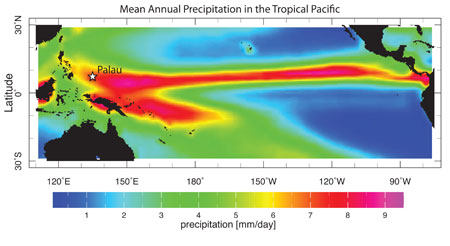Reconstructing Precipitation Variability
in the Western Tropical Pacific
over the past Millennium
By:
Julie Richey
U.S. Geological Survey
| When: | Friday, April 11, 2014, 10:30 a.m. to 11:30 a.m. Join us for coffee beginning at 10:00 a.m. |
| Where: | Seminar Conference Room, 10100 Burnet Road, Bldg 196-ROC, Austin, Texas 78758 |
| Host: | Nick Hayman, UTIG |
Click for a Live Broadcast.

Abstract
Modern seasonal and inter-annual precipitation variability in Palau is linked to both meridional movement of the Intertropical Convergence Zone (ITCZ) and changes in the Pacific Walker Circulation (PWC) associated with El Niño Southern Oscillation (ENSO). In order to assess how precipitation has varied on multi-decadal to centennial timescales, we present a proxy reconstruction of rainfall variability in Palau spanning the past 800 years.
We use compound-specific hydrogen isotope analysis ( D) of the algal lipid, dinosterol, to reconstruct hydrologic variability from lake sediments. Results indicate a long-term trend toward dryer conditions from 1200 Common Era (C.E.) to present in Palau, with several multi-decadal and centennial-scale intervals of relative wet and dry conditions.
The drying trend in Palau from the Medieval Climate Anomaly (MCA) to the Little Ice Age (LIA) is accompanied by cooling in the Indo-Pacific Warm Pool (IPWP) and a decrease in the zonal temperature gradient across the tropical Pacific Ocean.
A weakening of the Pacific Walker Circulation (PWC) from the MCA to the LIA could explain both the reduction in the zonal SST gradient and a drying trend in Palau. Neither a meridional shift in the ITCZ nor a change in the PWC completely explains the spatial pattern of precipitation proxy data in the tropical Pacific during this interval.




